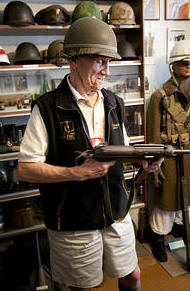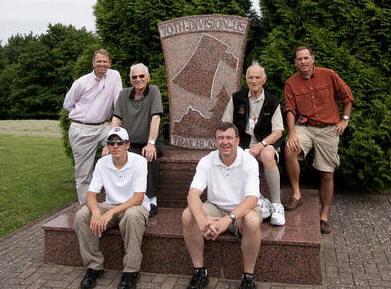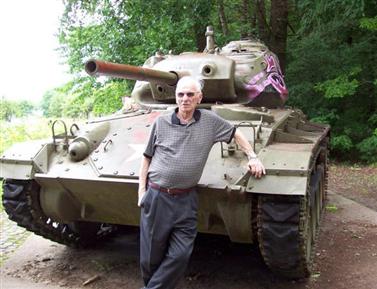Fighting World War II with Family
By Ted Heck
|
Southern California 25, Tennessee 0. This summer I finally learned the score
of the 1945 Rose Bowl.
My nephew Doug plugged in his laptop and Googled the result as we sat in a
restaurant recently in the village of Philippsbourg in Alsace Lorraine. We
were in France during a family visit to my old battlegrounds.
It had been 64 years since I sat under a huge rock on New Year’s Day and
wondered about the game, to take my mind off the predicament I was in. Our
rifle company had just been ambushed by German infantrymen as we marched
along a road in the dark. We had sought refuge on a promontory in the woods.
Doug knew more than that score. He had brought with him large contour maps
that he pulled from the Internet. He and his teenage son Adam and brother
Jim were able to find my long-ago rocky haven and even spot some leaf-filled
depressions that might have been our foxholes. Doug was able to identify the
area where one of our squads had been captured during the night and also the
route we took as we fought our way back to the village in the morning.
|
 |
I have returned to Philippsbourg several times over six decades, mostly in
reunions with comrades. Once to a dedication of a monument to the 70th
Infantry Division (Trailblazers). The stele is one of many tributes to us in
villages we liberated in the first three months of 1945.
This visit, however, was prompted by my younger brother Bill’s desire to see
for himself the sites I often talked about. He had seen a video interview I
did for the American Institute for History Education, an organization that
feels today’s teachers know little of what I call the “last of the
respectable wars.”
Bill, his sons and grandson flew to Germany from Texas, I from Philadelphia.
We picked up a van in Frankfurt and spent a day in Heidelberg, much of it
among the ruins of the castle that looms over the historic university city.
It was the right antidote for jet lag and a sleepless night on the long
flights.
We did not need Doug’s map to get across the Rhine River into France. The
van’s GPS system guided us to Hagenau, the spa town of Niederbronn,
Philippsbourg and the nearby hamlet of Baerenthal. Although one battalion of
our 275th Regiment had fought fiercely in Baerentahl, our focus on this trip
was on Philippsbourg. Our 3d Battalion and specifically my Company K spent
two weeks there fighting house-to-house and repelling tank attacks.
In one incident artilleryman Pfc George Turner, 45-years old and a veteran
of the first World War, stood in the middle of the street with a bazooka and
knocked out two German tanks. He won the Congressional Medal of Honor for
his bravery.
The fighting was fierce here because Philippsbourg was a main intersection
between two peaks in the heavily wooded Vosges Mountains and important to
the Germans in their drive southward toward Strasbourg.. They had just lost
the Battle of the Bulge, but had one last gasp: Operation Northwind, led by
Volksgrenadiers and elements of an SS mountain division, who were accustomed
to fighting in the snow.
Doug, a student of various American wars, used one of his maps to pinpoint
the cemetery where some of my men had dug their foxholes among the graves. I
had spent a night or two with them, shivering in the snow. (Daytime
temperatures rarely got into double digits.)
My family laughed when I recalled dining in the cemetery on steak and French
fries which the platoon cooked up, after they dispatched a wounded cow. A
sergeant butchered the animal, his men scrounged potatoes from a deserted
cellar and they used their helmets as pots. Soldiers took turns coming from
their frontline posts for a meal that did not come from a can or box.
The village’s main attraction for my family was the monument to our division
that stands tall in front of the town hall. But they were also interested in
the church that served as a first aid station. They explored pillbox ruins
from the Maginot Line, the ill-fated defensive line that could not hold the
Germans back when they invaded France in 1940.
We had lunch at Café Falkenstein, situated at the main intersection and were
delighted when its owner Patrick brought out his scrapbook.
A former mayor of the village, he has memorabilia about our 70th Infantry
Division Association, including items from the days of combat and photos of
numerous veterans who, like us, have come back to relive the time. (Our host
at the Hotel Kirchberg in Baerenthal, Veronique Loeb, is the daughter of that
village’s former mayor. He, too, has a scrapbook, a chronicle of the action
there, which he witnessed first hand.)
We moved on to many other villages that are forever grateful to our
division. Lixing and Grosbliederstroff were scenes of costly attacks. In the
latter Christophe Ultsch, Frenchman but an associate member of our division,
is custodian of a museum dedicated to us. We spent an afternoon examining
his exhibits, particularly photographs of some of my friends. His impressive
arsenal of pistols, grenades, rifles, and machine guns were handled by all
of us. Unlike most museums, this was a “Please Touch” one.
|
 |

|
|
Ted in the museum
|
A Heck of a gang. Front: Adam and Doug
Rear: Jim, Bill, Ted and Todd on Spicheren Heights
|
The most dramatic tribute to our division is atop Spicheren Heights. It is a
huge marble replica of our shoulder patch: red, white and green colors in
the shape of an axe, with a pine tree and snow-covered mountain. It
symbolizes our Trailblazer nickname. Nearby is a tank that the U.S. Army
donated to the community.

Bill on Spicheren Heights |
I described to the family how we had stormed through smoke to reach this
area, which had fortifications of the Siegfried Line, protecting the
city of Saarbrücken. Jim, Doug and Adam went down into bunkers we had
assaulted. War historian Doug took time to study other monuments in the
forest: many are dedicated to soldiers who fought in the Franco-Prussian
conflict in 1870. It reminded us that this region of France had changed
hands and was sometimes part of Germany.
Our family group grew when my son Todd and his wife Maureen joined us
for two days. They had been on holiday, bicycling along the picturesque
Moselle River before catching up with us.
During our combat-oriented itinerary we had many humorous moments:
family memories, anecdotes about friends and relatives. But nobody
laughed in the military cemetery in St. Avold. The largest U.S. military
cemetery in Europe has 10,489 graves. It once held more than twice as
many, but those casualties of war were repatriated to America at the
request of their families. There are 150 unknown soldiers buried here
and four Medal of Honor winners. The Walls of the Missing has 444 names
of men whose bodies were never recovered. |
Valerie Mueller, administrative assistant, led us among the rows to find
several graves I wanted to see again. She carried with her a bucket of wet
sand from Omaha Beach, which she rubbed on the tombstones’ indented names to
make them stand out in photographs. We stopped at the grave of Bernard Brons,
a fellow lieutenant who was killed leading a patrol that could have been
assigned to me. We also visited the grave of Bill Beck, with whom I went to
college, and John Lally, a high school classmate.
The fierce fighting of Philippsbourg and Baerenthal was attested to here by
a printout Valerie gave us. There are 39 members of the 275th Regiment
buried in St. Avold. Twenty-seven of them died in the first 10 days of
January, 1945.
Historians Donald Pence and Eugene Peterson wrote of this period in their
“Ordeal in the Vosges” book. Their numbers for the regiment: a third of our
3,000 men were killed, wounded or missing in action, or evacuated with
trenchfoot and frozen extremities.
I came close to being under one of the crosses. In March when we walked into
the city of Saarbrücken with no opposition, I volunteered to scramble over
the rubble of a bombed bridge in the Saar River to question several
civilians visible on the other side. They told me, and I yelled back to the
commanding officer, that the German soldiers had pulled out the day before.
When I crossed back over the river, I asked a sergeant to give me a hand
getting up the bank. I grabbed his carbine by the barrel and he was pulling
me up when the gun went off. The bullet skipped through my belly and into my
leg like a flat stone thrown on the water. I was the only casualty and my
war was over.
I spent six weeks in the hospital before returning to duty. During my stay
the hospital’s head doctor came to the ward to present me with a Silver Star
I had won for leading an attack in Philippsbourg in January and a Bronze
Star for capturing nine Germans hiding in a cellar in Etzling in late
February.
He also handed me a Purple Heart, which I refused. I was embarrassed enough
by such a weird version of friendly fire.
My family wanted to see exactly where this had happened. We drove up and
down along the river, but Doug’s maps couldn’t help. A superhighway now
dominates the riverfront, so the group had to believe my memory and my
scars.
After Saarbrücken we drove through the rolling hills of western Germany to
the spa town of Bad Kreuznach and on to Bingen on the Rhine River. We spent
the final day of our action-packed itinerary on a river cruise up to the
town of St. Goar, past steep terraced vineyards, the rocks of the Lorelei
legend and castles that seemed to float by every 10 minutes.
A relaxing day, yet one in which the family still asked questions about the
war. Brother Bill had come up with the idea of this remembrance of war and
insisted that we were all his guests. He had been in the Army, too, and
wanted to be an infantryman. He was in Officer Candidates School at Fort
Benning, Georgia, when the war ended.
The family grasped both the big and the little picture of World War II. The
big picture of generals who dealt with campaigns, strategies and logistics.
And the little picture of simple soldiers whose concerns were scarier and
had shorter timetables.
I was moved by the family’s interest in this dramatic period of my life.
They plan to share it with others in videos that Jim and Doug recorded as we
covered the ground.